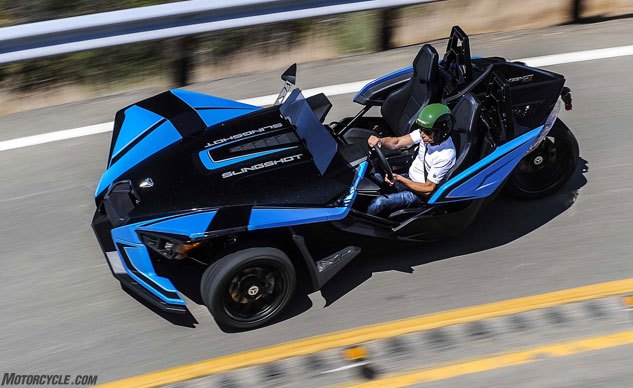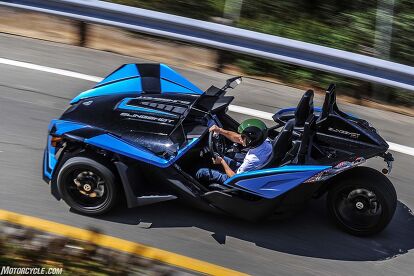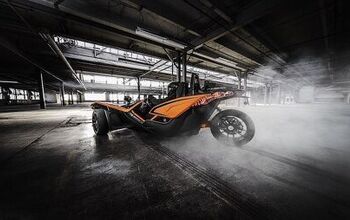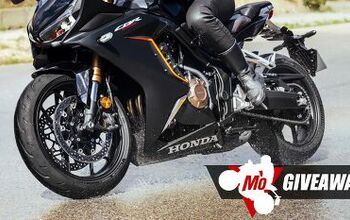2018 Polaris Slingshot SLR Review
An autocycle, not motorcycle, but really fun to ride/drive!
Remember when the Slingshot first debuted and motorcyclists poo-poo’d the contraption as a waste of money that nobody would want? Well, it’s three years later and our roads are now spattered with some 20,000 Slingshots being driven by all sorts of people, many of them motorcycle enthusiasts.
2015 Polaris Slingshot Review – First Ride/Drive
As for the Slingshot’s initial designation as a motorcycle because it has fewer than four wheels, some 40 states in the U.S. now deem the trike to be an autocycle, a distinct term that places it in an area somewhere between a motorcycle and a car. The Slingshot looks like a Le Mans prototype race car from the front and, from the rear, like a plastic chairlift with wheel stuck on back.
Less obfuscatory is the Slingshot’s fun-to-drive factor, which is soaringly high when pointed down a twisty road on a sunny day. Polaris rolled out its latest Slingshot range to the media last week and sent us off to Malibu and the sinuous roads that climb into the Santa Monica mountains. Although the Slingshots lean the wrong way in corners and can never be as fun as a motorcycle, they are a LOL hoot when carving up a canyon road.
Polaris Slingshot vs. Morgan 3-Wheeler vs. Can-Am Spyder F3
The 2018 Slingshots start at $19,999 for the new S model, a $2,000 reduction from last year’s entry-level Slingshot. Having already tested the lower-end Slingshots, we jumped past the SL version ($25,499) and into the upper-range SLR with forged-aluminum wheels and a navi package added to the newly larger (7-inch) Ride Command infotainment system, retailing at $28,999. Later, we’d hop into the top-range SLR LE ($30,999).
2018 Polaris Slingshot Lineup Announced
All Slingshots are powered by a 2384cc four-cylinder motor sourced from GM – old Saturn Sky and Pontiac Solstice owners (anyone…?) will recognize it. The DOHC mill isn’t particularly sonorous, but its 166 lb-ft of crankshaft-rated torque is plenty enough to overwhelm its lone rear tire, upsized in width on the SLRs to 305mm. Polaris uses its own ECU tuning to extend the engine’s rev ceiling to a fairly lofty 7200 rpm, with 173 hp peaking at 6200 rpm.
So, no wheelies here, but some seriously impressive pace on Latigo Canyon and the surrounding environs. Turns with mid-corner bumps or gravel that would terrify a motorcycle rider are shrugged off without worry in a Slingshot, as the pair of 225/45-18 front tires will never fold in and threaten the structural viability of your collarbones.
Tanner Foust drifting a 400-hp Slingshot
Helping keep the Slingshot from sailing off a cliff are electronic safety systems for when its girthy 69.1-inch front track runs out of grip – that’s inches wider than a Corvette. Polaris tells us the traction control has been tuned to allow a generous 20% slip rate, which allows a decent entertainment factor. Happily, the TC can be switched off by a button on the console, which enables the longest, safest rolling burnouts of any “motorcycle.”
If you’re patient enough to hold down the TC button for more than a few seconds, your inner hooligan will be delighted to see the Slingshot’s stability-control warning lamp illuminate, completely eliminating the reins of electronic nannies. Big kudos to Polaris for avoiding the grip of legal counsel and placing a priority on driving entertainment.
A colleague at a car magazine posed the potentially Slingshot-killing question: For $30k, would you rather have a Miata or a Slingshot SLR?
Well, if the choice would be for a one-and-only car, the Miata and its roof and doors would be the easy decision. But if it was a choice for a second or third vehicle – a recreational one – I might choose the 1750-pound Polaris. First off, the Slingshot is capable of slinging itself through the quarter-mile sprint in the mid-13-second bracket, which is a full second quicker than than possible in a 500-pounds heavier Miata. While that’s slow by sportbike standards, it’s modestly quick for a modern car – or actually quick for a 50 year old muscle car, like Hemi ’Cuda quick.
The absence of a roof (and airbags and bumpers…) is part of the reason why the Slingshot weighs less than a ton, and the interior’s exposure to the elements has a few deleterious effects because of it. First, as a car, it offers abysmal weather protection. The windshield is better described as a deflector than a shield, and combined with the lack of doors, makes for a loud and onerous place to be during freeway speeds and above. Full-face helmets with Bluetooth communicators would be a desirable option for highway travel.
With a lidless and windowless car, its interior must be made impervious to sun and rain, and this means everything inside has to be waterproof. So you won’t find leather and mahogany, but rather plastic, fiberglass and rubber. This renders several cheap-feeling touch points that will make some wish they were in a Miata.
The SLR upgrade pays off on the most important touch points, with noted accessory company Sparco providing the gearshifter, steering wheel and drilled pedals. The biggest benefit is the aluminum shifter, which delivers far greater precision and slightly shorter throws when rowing gears. The steering wheel boasts a racy and digitally pleasing shape, but its rubberized surface feels less than premium. Feedback through the electric power steering is modest but helpful, and it boasts much better self-centering action than the first Slingshot we drove, despite Polaris claiming there have been no geometry revisions to the front end. The brake pedal feels firm clasping on a trio of 298mm iron rotors through braided steel lines.
As an autocycle, the Slingshot resides in between two camps: motorcyclists and car drivers. People in the former category can be unwilling to consider a three-wheeled car as a proper recreational vehicle, while people in the latter will decry the Slingshot’s obvious lack of practicality and unsuitability for inclement weather.
After a full day of driving the Slingshot in an ideal environment for such a vehicle, and frequently grinning like a fool while banging off shifts and sliding its mono-wheel rear end, I believe there’s a reasonable case to me made for Polaris’ oddball trike. It’s far more accessible to passengers than a motorbike, and it’s more enjoyable to drive enthusiastically than most inexpensive sports cars. So, while it would make for a horrible sole vehicle, it makes for a lighthearted pleasure to drive whenever the sun is shining and the roads are twisty.
“We create new ways for people to recreate,” quipped Polaris’ Gary Gray during our ride day.
We believe defining the Slingshot as a recreational vehicle is apt, and one would look right at home in the garage next to a UTV, PWC or snowmobile.
2018 Polaris Slingshot SLR
+ Highs
- Highly entertaining (for a car)
- Grants instant celebrity status
- Stability control off switch
– Sighs
- Absence of weather protection
- Leans the wrong way
- Obnoxious gear whine
2018 Polaris Slingshot SLR Specifications | |
|---|---|
| Color / Graphics | Electric Blue (Ghost Gray and Lime Squeeze for LE) |
| Engine | GM Ecotec 2.4L DOHC 4 Cylinder |
| Displacement (cid/cc) | 2384 cc |
| Bore and Stroke | 88mm x 98mm |
| Compression Ratio | 10.4:1 |
| Valve Train | DOHC, VVT |
| Fuel | 91 octane or higher |
| Rev Limit (RPM) | 7200 RPM |
| Peak Power (HP) | 173 HP @ 6200 RPM |
| Peak Torque (ft-lbs) | 166 ft-lbs @ 4700 RPM |
| Fuel (Gallons/Liters) | 9.77 Gallons / 37.1 Liters |
| Brake Rotors (Front) | Vented cast iron rotor, aluminum center hub, 298mm diameter |
| Brake Rotors (Rear) | Vented cast iron rotor, aluminum center hub, 298mm diameter |
| Front Tire Type | Kenda SS-799 |
| Front Tire Size | 225/45R18 |
| Front Wheel Type | Forged Aluminum |
| Front Wheel Size | 18×7.5 J |
| Rear Tire Type | Kenda SS-799 |
| Rear Tire Size | 305/30R20 |
| Rear Wheel Type | Forged Aluminum |
| Rear Wheel Size | 20×11.0 J |
| Clutch Type | Dry, Single Plate, Hydraulically Actuated |
| Transmission | 5 Speed Synchromesh with Reverse |
| Gear Shift Pattern | H |
| Final Drive Type | Carbon Fiber Reinforced Belt, 36mm x 147T |
| Battery | 30AH, 12V, 400 CCA |
| Headlight | Projector H9 65w |
| Auxiliary Light | Projector H3 55w |
| Tail/Brake Light | LED |
| Turn Signals | LED |
| License Plate Light | LED |
| Speedometer | LED |
| Speedometer & Indicator Lights | LED |
| ABS (Anti-Lock Brakes) | Standard |
| ESC (Electronic Stability Control) | Standard |
| Traction Control | Standard |
| Factory Warranty | 2 Years |
| Overall Vehicle Height | 51.9 in/1318 mm |
| Overall Vehicle Length | 149.6 in/3800 mm |
| Overall Vehicle Width | 77.9 in/1980 mm |
| Max Wet Weight | 1749 lbs. |
| Overall Width (in/mm) | 69.1 in/1755 mm |
| Wheelbase (in/mm) | 105.0 in/2667 mm |
| Ground Clearance (in/mm) | 5.0 in/127 mm |
| Actuation | Rack-and-pinion |
| Assist | Polaris EPAS, Speed Sensitive |
| Steering Turns, lock-to-lock | 3.2 |
More by Kevin Duke






































































Comments
Join the conversation
30K for the top of the line? Gee you can have that and from what I have heard their abysmal reliability ratings too. People really will buy anything.
It's different, and that's why a lot of people will buy one. I just got a leftover 2021 for 20 grand and some change. Is it practical? Hell no but I've been a two-wheeler for 58 years now and also bought a new Triumph T100. Why, because I've always wanted one. There's no common sense to motorcycles, auto-cars or three wheelers. We love them because people think we're nuts and that's good with me.